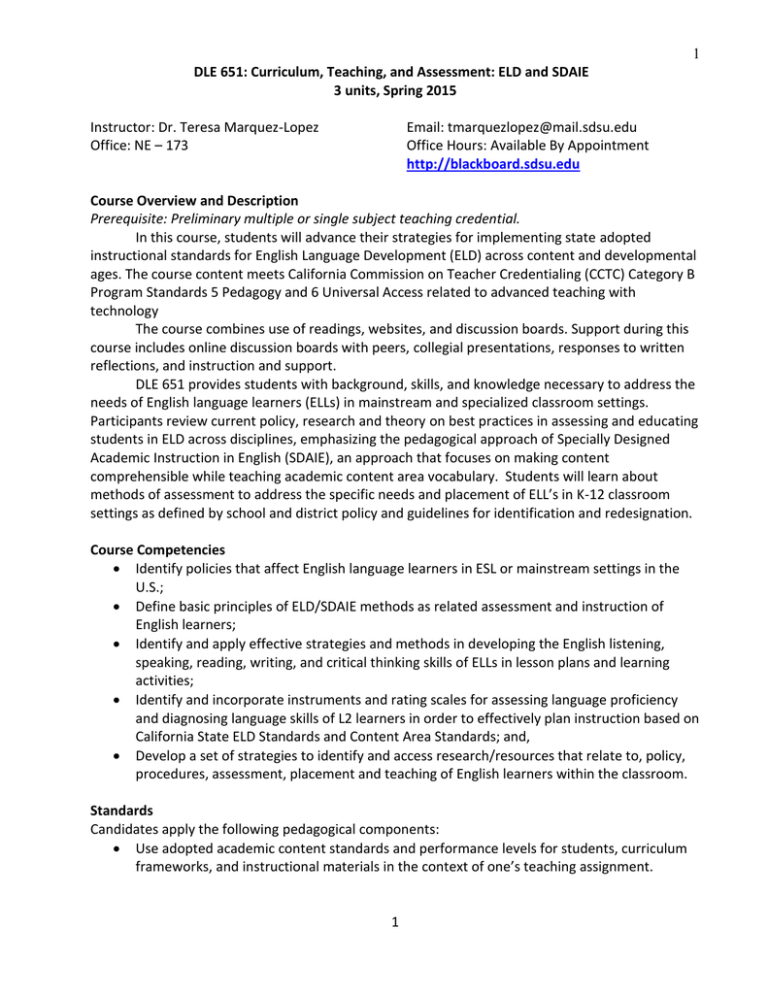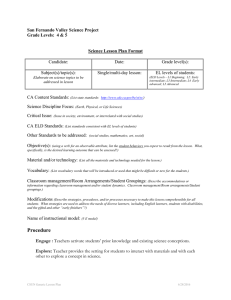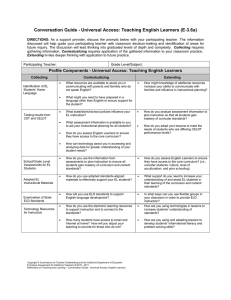1 Instructor: Dr. Teresa Marquez-Lopez Email:
advertisement

1 DLE 651: Curriculum, Teaching, and Assessment: ELD and SDAIE 3 units, Spring 2015 Instructor: Dr. Teresa Marquez-Lopez Office: NE – 173 Email: tmarquezlopez@mail.sdsu.edu Office Hours: Available By Appointment http://blackboard.sdsu.edu Course Overview and Description Prerequisite: Preliminary multiple or single subject teaching credential. In this course, students will advance their strategies for implementing state adopted instructional standards for English Language Development (ELD) across content and developmental ages. The course content meets California Commission on Teacher Credentialing (CCTC) Category B Program Standards 5 Pedagogy and 6 Universal Access related to advanced teaching with technology The course combines use of readings, websites, and discussion boards. Support during this course includes online discussion boards with peers, collegial presentations, responses to written reflections, and instruction and support. DLE 651 provides students with background, skills, and knowledge necessary to address the needs of English language learners (ELLs) in mainstream and specialized classroom settings. Participants review current policy, research and theory on best practices in assessing and educating students in ELD across disciplines, emphasizing the pedagogical approach of Specially Designed Academic Instruction in English (SDAIE), an approach that focuses on making content comprehensible while teaching academic content area vocabulary. Students will learn about methods of assessment to address the specific needs and placement of ELL’s in K-12 classroom settings as defined by school and district policy and guidelines for identification and redesignation. Course Competencies Identify policies that affect English language learners in ESL or mainstream settings in the U.S.; Define basic principles of ELD/SDAIE methods as related assessment and instruction of English learners; Identify and apply effective strategies and methods in developing the English listening, speaking, reading, writing, and critical thinking skills of ELLs in lesson plans and learning activities; Identify and incorporate instruments and rating scales for assessing language proficiency and diagnosing language skills of L2 learners in order to effectively plan instruction based on California State ELD Standards and Content Area Standards; and, Develop a set of strategies to identify and access research/resources that relate to, policy, procedures, assessment, placement and teaching of English learners within the classroom. Standards Candidates apply the following pedagogical components: Use adopted academic content standards and performance levels for students, curriculum frameworks, and instructional materials in the context of one’s teaching assignment. 1 2 Use and interpret student assessment data from multiple measures for entry level, progress monitoring, and summative assessments of student academic performance to inform instruction. Plan and differentiate instruction using multi-tiered interventions as appropriate based on assessed individuals, academic language and literacy, and diverse learning needs of the full range of learners (e.g., English learners and speakers of non-standard English). Ensure academic achievement for special populations, Protect and support students by designing and implementing equitable and inclusive learning environments. Support academic achievement for students from all ethnic, race, socioeconomic, cultural, academic, and linguistic or family background; gender, gender identity, and sexual orientation; and students with a combination of special instructional needs. Use a variety of resources (including technology-related tools, interpreters, etc.) to collaborate and communicate with students, colleagues, resource personnel, and families to provide a full range of learners equitable access to the state-adopted academic content standards. Adhere to legal and ethical obligations for teaching English learners including the identification, referral, and redesignation processes. Implement district policies regarding primary language support services for students. Plan instruction for English learners based on the students’ levels of proficiency and literacy in English and primary language as assessed by multiple measures, such as the California English Language Development Test (CELDT), the Common Core “Smarter Balance,” and local assessments. Based on teaching assignment and the adopted language program instructional model(s), implement one or more of the components of English Language Development (ELD): gradelevel academic language instruction, ELD by proficiency level, and/or content-based ELD. Design curriculum and supportive instructional materials for students at differing ELD proficiency levels. Required Reading Zwiers, Jeff & Crawford, Marie (2011). Academic Conversations: Classroom Talk That Fosters Critical Thinking and Content Understandings. Portland, Maine: Stenhouse Publishers. State Board of Education, adopted July 9-10, 2014, ELA/ELD Framework, Sacramento: California Department of Education Publishing. Online Readings Olsen, Laurie (2010). Reparable Harm: Fulfilling the Unkept Promise of Educational Opportunity for California’s Long Term English Learners. Long Beach, CA: Californians Together www.californianstogether.org Trumbull, Elise & Pacheco, Maria (2005). Human Development, Culture, and Cognition Vol. 1, The Education Alliance at Brown University. Pdf is linked to our course on Blackboard. Various texts for this course are posted for you under “Course Documents” on our class Blackboard site. 2 3 You will also need regular access to the State Board of Education, adopted July 9-10, 2014, ELA/ELD Framework, Sacramento: California Department of Education Publishing. www.cde.ca.gov/ci/rl/cf/elaeldfrmwrksbeadopted.asp Supplemental Resources According to Grade Level and Interest Cadiero-Kaplan, (2004). Literacy Curriculum &* Bilingual Education: A Critical Examination Echevarria, J., Vogt, M. & Short, D. J. (2014). Making Content Comprehensible for Elementary English Learners: The SIOP Model. Boston, MA: Pearson, Inc. Echevarria, J., Vogt, M. & Short, J. (2010). Making Content Comprehensible for Secondary English Learners: The SIOP Model. Boston, MA: Pearson, Inc. Herrell, A. & Jordan, M. (2012). Fifty Strategies for Teaching English Language Learners, 4th Ed. Boston: Pearson Education. Gibbons, P. (1993). Learning to Learn in a Second Language. Portsmouth, NH: Heinemann. ($3 new on Amazon) Assignment Guidelines All written assignments will be typed, double-spaced, 12 font with 1 inch margins and edited for use of Standard Academic English (SAE). The content of all writing assignments will be evaluated based on the level of higher order thinking skills demonstrated by the student according to the criteria for grading included in this syllabus. Late assignments will be penalized five percent. Course Evaluation (policy on grading): As a graduate student, one is expected to produce high quality work that does not fall lower than a “C”; conversely, a grade of “A” is not simple or easy to earn. Should the quality of a product not be up to the professor’s standards, the student may be asked to resubmit work so that it reflects an understanding and adherence to the criteria included in the grading rubric. (93-100%) = A (90-92.9%) = A- (87-89.9%) = B+ (86.9-83%) = B (82.9-80) = B- (76.9-73) = C (77-79.9) = C+ (70-72.9) = C- Assignment Descriptions A: Attendance/Participation: 20 points Attendance and participation are necessary elements to succeed in class and to accomplish your professional and educational goals in the program. Participation includes coming prepared to class having completed all assignments, online assignments, and readings. You will be allowed one absence during the session. After that absence, 5% will be deducted from your final course grade. In the case of ongoing medical needs, please consult instructors for special arrangements. It is your responsibility to get course notes and any information missed from a peer who is enrolled in the course. Cell phones and laptops are prohibited during class including text messaging. If there is an emergency the instructor must be notified. 3 4 B: Workshop Presentation: Due throughout the semester 20 points Workshop presentation, or any other form of powerpoint and/or online presentation: Describe chapter and model a strategy for English Language Development (ELD) with examples of what can be utilized in the classroom. Students w demonstrate links between methods highlighted in the text and the reality of their own classrooms. Presenters will make available any additional links presented and activities in the form or a resource page at the end of the on line presentation. (site all sources). Presentations are limited to (no more than) 8 power point pages and should have an interactive format that demonstrates at least two strategies found within the ELA/ELD Standards or Academic Conversations. C: Lesson Plan & Assessment Development & Implementation 20 points Students will integrate knowledge of the CA ELD and Common Core standards for their subject/grade levels by designing a unit of study that engages students in academic conversations created through various forms of classroom conversations. The unit of study will include formative, summative, and diagnostic assessments as integral to instructional supports for academic language development for students at emerging, expanding, and bridging levels of ELD. D: Inquiry Project & Research Presentation 20 points Each student will submit a research proposal, conduct research, write a summative technical report, and present his/her paper to the class. The project proposal form and outline for the summative technical report are posted on Bb under “Assignments.” Students will have approximately 20-30 minutes in which to present their findings to colleagues and this should take the form of a professional development session, including audience awareness (learning needs, multiple modalities, anticipated questions, and relatedness). E: Journals: Due throughout the semester 20 points Statement on Cheating and Plagiarism Cheating is the actual or attempted practice of fraudulent or deceptive acts for the purpose of improving one’s grade or obtaining course credit; such acts also include assisting another student to do so. Typically, such acts occur in relation to examinations. However, it is the intent of this definition that the term ‘cheating’ not be limited to examination situations only, but that it include any and all actions by a student that are intended to gain an unearned academic advantage by fraudulent or deceptive means. Plagiarism is a specific form of cheating which consists of the misuse of the published and/or unpublished works of others by misrepresenting the material (i.e., their intellectual property) so used as one’s own work. Penalties for cheating and plagiarism range from a 0 or F on a particular assignment, through an F for the course, to expulsion from the University. For more information on the University’s policy regarding cheating and plagiarism, refer to the Schedule of Courses (‘Legal Notices on Cheating and Plagiarism’) or the University Catalog (‘Policies and Regulations’). Students with Disabilities Americans with Disabilities Act (DA) Accommodation: The University is committed to providing reasonable academic accommodation to students with disabilities. The Student Disability Services Office provides university academic support services and specialized assistance to students with disabilities. Individuals with physical, perceptual, or learning disabilities as addressed by the 4 5 Americans with Disabilities Act should contact Student Disability Services for information regarding accommodations. Please notify your instructor early in the semester so that reasonable efforts can be made to accommodate you. If you expect accommodation through the Act, contact the Student Disability Services Office http://www.sa.sdsu.edu/dss/dss_home.html at (619) 5946473. Students who need accommodation of their disabilities should contact the instructor early in the semester to discuss specific accommodations for which they have received authorization. If you have a disability, but have not contacted Student Disability Services at 619-594-6473 (Calpulli Center, Suite 3101), please do so before making an appointment to see the instructor. Religious Observances University Policy on Absence for Religious Observances includes the following: “By the end of the second week of classes, students should notify the instructors of affected courses of planned absences for religious observances. Instructors shall reasonably accommodate students who notify them in advance of planned absences for religious observances.” Please notify the instructor in a timely manner and a reasonable accommodation will be reached. Safety Issues Sharing your peers’ online work or written statements in online discussion boards is prohibited. Any work, assessments, or information about any of your students’ must provide absolute anonymity to them. Blackout any student names on student work or other documents. Always refer to students as Student 1, Student 2, and so on. Syllabus Is Subject to Change This syllabus and schedule are subject to change in the event of extenuating circumstances. Course Schedule, Assignments, and Due Dates (see full matrix on Bb under “Assignments”) Date What We’ll Focus on Today Assignment 1/21 Introductions Read through course syllabus and review assigned reading Assessing our knowledge and understanding of ELA/ELD Standards Overview and Implications, CDE and the Common Core Standards http://player.vimeo.com/video/8039571 7?byline=0 1/28 Overview of the California English Read: ELA/ELD Introduction to the Language Development Standards Framework (Posted on BlackBoard) and Proficiency Level Descriptors Transitioning to the New CA English Create My Digital Chalkboard account Language Arts/English Language Development Standards 2/4 Introduce: My Digital Chalkboard https://www.mydigitalchalkboard.or g/ Guest Speaker: (tentative) Dr. Karen Cadiero-Kaplan Read: Zwiers & Crawford: Introduction and Chapter 1 5 6 “Reflective Voices: Valuing Immigrant Students and Teaching with Ideological Clarity” Trumbull & Pacheco text pages 1 - 25 Complete: Activities 1 & 2 Proverbs and the Values They Communicate Exploring Values, Beliefs and Ideas (use the worksheet posted under “Assignments” on Bb) cut & pasted there Ideological Clarity Task (see details under “Assignments”) Read T & P pages 70 - 91 Complete: Activity 7 2/11 2/18 2/25 3/4 3/11 3/18 3/25 4/1 4/8 4/15 4/22 4/29 5/6 6



